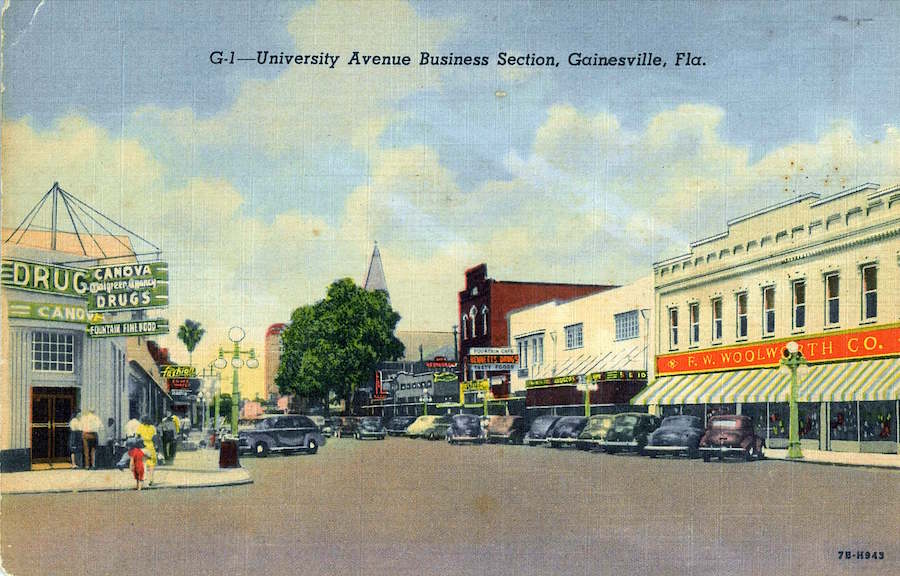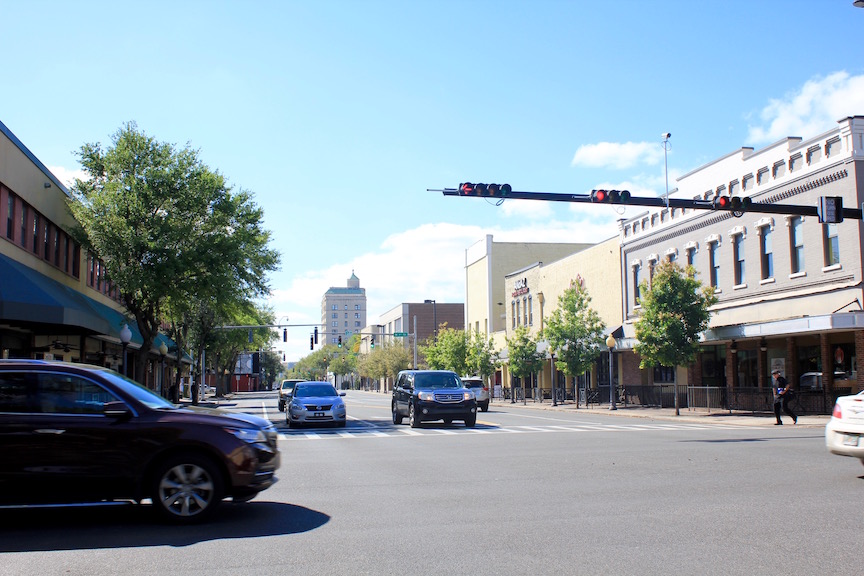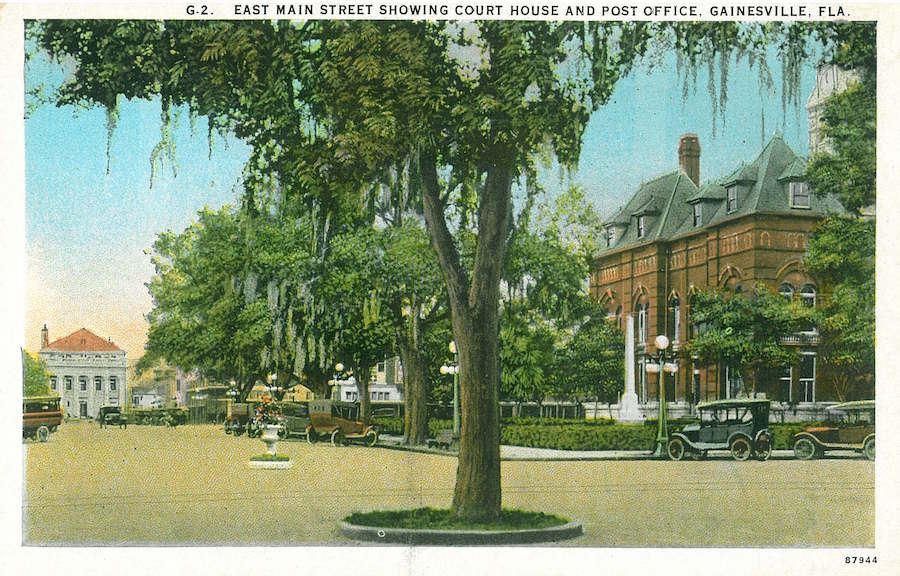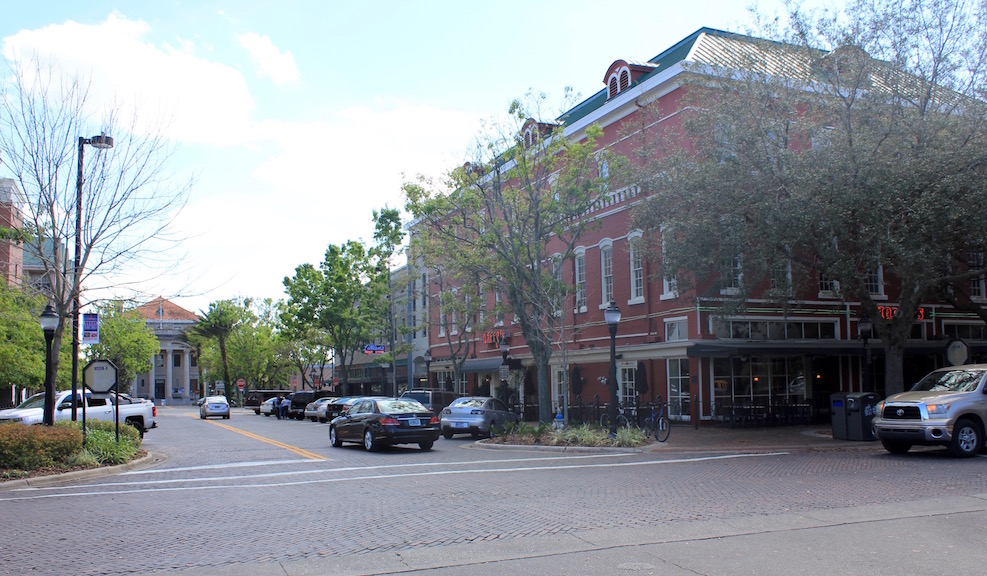By Molly Donovan | April 2, 2017
The cracked blue paint is fading on the facade of the building that once housed The Jam music venue.
The building on West University Avenue — once filled with bands and their fans — is now graced with only dust and a few pieces of trash.
In May 2016, University of Florida developers told Blake Briand and the venue’s two other owners that they could no longer rent the space. For in a matter of months, the wrecking ball would arrive, and the whole block would be reduced to rubble.
“We didn’t really have a say in the matter,” Briand said. “We had to make a decision in a short amount of time to close or stay open” until the lease ended.
The building was to be demolished at the end of summer in 2016 to make way for the planned development for the site: UF-owned apartments. So Briand closed the doors in May, three months earlier than required, because summer business isn’t great in Gainesville.
“Fast forward a year and that building is still there,” he said. “We could have stayed.”
Briand said he notices differences in the way that development projects are approached by city and those done by university. Specifically, he said, the city works to remodel and repair, while UF claims lots eventually and despite any objections with the aim to level and rebuild.
“When the university wants something, they get it,” Briand said. “They have infinitely deep pockets, and if they have their eye on something downtown, they’re gonna take it.”
Briand’s comments highlight a clear development divide taking place in the heart of Gainesville: rampant redevelopment around the university and a more mediated approach east of UF and into downtown.
The construction — happening city-wide, but mostly on University Avenue and on 13th Street — comes as part of plans by the city’s Community Redevelopment Agency and the university to renew Gainesville.
To the CRA, that means solving problems one project at a time.
“A lot of what we try to do is figure out what issues people have … that we can try to solve, whether it be acting as an advocate through the city or addressing their issues through the redesign and redevelopment of that area,” Sarah Vidal-Finn, the agency’s director, said of how officials decide which projects to work on.
Money, at the end of the day, runs the show, and you kind of can’t blame them for that.
But as the city looks toward such improvements, Briand and other business owners greatly affected by the construction, like those at Visionary Crossfit downtown, say the push for progress comes off as aggression toward local businesses.
“If we were over there [closer to UF], we’d already be gone,” Visionary co-owner Jesus Martinez said. “Those guys are ruthless. When they want something, they’re going to do whatever it takes to get it.”
But Briand said he does understand the financial reasoning behind the development.
“Money, at the end of the day, runs the show, and you kind of can’t blame them for that,” he said. “At the same time, they have no regard for the historic businesses.”
The block on which The Jam sits also houses two former tattoo shops, the Unified Training Center and an old two-story house constructed in 1925. The buildings are still standing, but they could be cleared at any time for the apartments..
Meanwhile, the former Independent Florida Alligator newspaper building — which was about 90-years-old — was knocked down in 2016 to make way for another apartment complex. Leonardo’s pizza restaurant, a Gainesville staple separated from the university only by a gas station, is also slated for redevelopment.
But the CRA’s downtown projects — including the recent renovation of Bo Diddley Plaza and the building of Depot Park in a vacant field — have seen little to no demolition.
The reason for the different approaches to construction is simple, said Laura Dedenbach, owner of Dedenbach Planning Associates, which is contracted to help with some of Gainesville’s redevelopments.
In any city, she said, developers take a different approach to planning depending on the area and types of buildings involved.
“The type of development you can see — whether it’s tear down and redo, or adapt and reuse — is in large part determined by codes and secondarily by the type of building that’s there,” Dedenbach said.
“If you think about cities in the same way that you think of an ecosystem, there is a balance that needs to occur.”
The West University Avenue developments are part of the University of Florida’s Strategic Development Plan, which was released in December 2016.
Modifications to downtown, meanwhile, are mostly part of the Community Redevelopment Agency’s plan for downtown redevelopment, which was adopted by the Gainesville City Commission in 2011.
A main goal of the Strategic Development Plan is to provide more housing options for college students moving to Gainesville, as evidenced by the complexes slotted for The Jam and the Alligator plots.
The Strategic Development Plan also envisions more “open spaces,” bike lanes and improvements to outdoor amenities but doesn’t include a list of specific projects like the CRA’s downtown development plan.
The Strategic Development Plan “isn’t a plan in the sense of specific things that we’re going to do in a specific geographic area,” said Linda Dixon, director of planning for UF’s Department of Planning, Design and Construction. “It touches on that, but it’s not a plan in the way you might think of a physical plan.”
But the organizations behind both plans — UF developers, the Community Redevelopment Agency and city commissioners — all work closely together, Dixon said.
“UF has worked with the CRA and the City Commission very closely,” she said. “They are going to be even more important as we go forward.”
After the Strategic Development Plan was approved in December, development began with the renovations on UF’s Plaza of the Americas and the new Innovation Square, a hub for Gainesville start-up businesses between UF and downtown and south of University Avenue.
As developers move forward on all parts of the plan, local businesses should not worry, Dixon said.
“I think we very much are supportive of local, homegrown businesses,” she said. “Many of them are UF graduates, and we certainly want to see UF graduates succeed.”
If anyone were to come in and close businesses, it would be private developers, not UF or the CRA, Dixon said.
“For the community to succeed,” she said, “businesses have to come in that can employ students and employ people in the community, and really give people here an opportunity to have more job options.”
The CRA divides its projects and initiatives into four redevelopment areas of Gainesville: Fifth Avenue and Pleasant Street, Eastside, Downtown, and College Park and University Heights, which is the closest of the four to UF.
Each area is approached in a different way, and that sometimes affects the types of projects and methods of development, Vidal-Finn said.
“If you just think about College Park/University Heights and how it wraps around campus — there are a lot of students, it’s much busier — there’s a lot more commercial development,” Vidal-Finn said. “That area brings in over half of [the CRA’s] revenue.”
Money brought into city from each zone has to then be spent within the boundaries of that area, she said. For that reason, more money goes into the university area than Eastside, which brings in only 8 percent of the CRA’s revenue.
“The challenge is, how do we leverage the little funding that we have to make a big impact in [the Eastside] area?” she said. “It means potentially leveraging city dollars and partnering on projects — also maybe leverag[ing] programs with existing agencies that are doing good work.”
As development proceeds, though, Vidal-Finn said the CRA will always keep local businesses and historic buildings in mind.
“Who lives there? What’s the legacy of each neighborhood?” Vidal-Finn said. “There’s just so many stories in each one of these districts because they comprise a bunch of neighborhoods.”
To a degree, change is good. You need to move with the times with history in mind.
While some businesses amid redevelopment have been negatively impacted, others have persevered.
Outside Krispy Kreme on Northwest 13th Street near UF, the neon red of the “Hot Now” sign shines bright.
Sitting between The Standard, a new high-rise apartment complex, and a new Publix Supermarket, the small building looks like a mouse next to an elephant. The establishment has lived there for years, and Courtney Russell, the store’s manager, said it’s not going anywhere anytime soon.
“We own the property and also the building itself, so even if they wanted to purchase the property, it would have to go through us,” said Russell, whose family has run the store for three generations.
Despite nearby businesses like Burrito Brothers closing in the face of construction, Krispy Kreme is actually doing better because of it, Russell said.
“We have construction workers that come through and buy things on a regular basis,” she said. “There have been a couple challenges: Different roads have been closed, and that’s caused some traffic issues. But for the most part … we’ve been pretty untouched, and we’ve stayed busy.”
The construction led to concerned customers calling daily to ask if Krispy Kreme would be next to close. But Russell assured them that they had nothing to worry about.
“To a degree, change is good,” she said. “You need to move with the times with history in mind. We’ve embraced change, but we know we have a lot of history for people. For that reason, we’ve kept the sign up even though it no longer meets city codes.
“We’re here to stay.”
Meanwhile at the Visionary Crossfit gym on South Main Street in downtown, Martinez and his co-owner and wife, Carrie Martinez, said they haven’t been impacted at all by the construction — yet.
“Unfortunately, some amount of growth has to happen,” Carrie Martinez said. “That’s why businesses like us, if we can get in there and also ride this wave of development, we can really form it the way we want.”
The Martinezes said that since opening January 2016, they have spruced up the facade of their building with landscaping and painting to avoid attracting the attention of the CRA.
But in watching the differences in the way the CRA approaches projects versus those being done closer to UF, they said they’re glad they decided to settle downtown.
As development stretches toward them, though, the Martinezes said they worry that one day, they’ll be approached by the CRA.
“I’ve already spoken to some developers that are going to be moving to this area for sure,” Jesus Martinez said. “It’s slowly expanding this way, and it’s gonna get here eventually.”
For now, all they can do to stay put is continue to show the CRA they’re willing to work together, the Martinezes said.
“I think there’s a problem with communication and getting the word out to people like us,” Carrie Martinez said. “[The CRA] offers thousands of dollars to fix homes and help businesses in this area. It’s just a matter of getting the word out and being fair. Who decides what gets fixed and what doesn’t? That’s where the greed comes in.”
As all the redevelopment moves forward, Peggy Macdonald said she worries that Gainesville’s historical footprint isn’t holding much weight in the conversation.
“There’s many people who have worked for a long time to protect our history and our historic buildings,” said Macdonald, a Gainesville native and the executive director of the Matheson History Museum. “But now that we’re out of the recession, there’s just rapid development.”
The Southeast Historic District — which includes the Duckpond area on East University Avenue and the bed and breakfasts there — will at least be preserved because they are protected, she said.
But buildings downtown and on West University Avenue also are some of the city’s most historic places, and though they’ve changed and warped as the city has aged, they still deserve special historical considerations, Macdonald said.
As a historian, she said she has heard a lot of concern that the development is changing the character of Gainesville.
“It’s good to have some new development. It’s good to add hotels and restaurants,” Macdonald said. “But I wonder about the architecture. Pretty soon, there will be no sense of architecture anymore — no sense of beauty, just high rises.”
Gainesville is a city where history is important, and losing that would mean losing a crucial part of the town, she said.
Briand has moved on professionally since The Jam closed in May 2016 and is now working mainly as a carpenter. But when he drives along University Avenue, it still stings to pass the shell of his old building.
He called The Jam “a unicorn,” and now it is gone with no prospects of returning.
The block’s development is “short-sighted, and it’s selfish,” Briand said. “I guess there’s some people that believe in absolute capitalism, but I think there’s a middle ground. We need to sustain the unique flavor that we have, but we’re not.”
Header photos by Jordan McPherson and Martin Vassolo
 Special Report from WUFT News
Special Report from WUFT News



